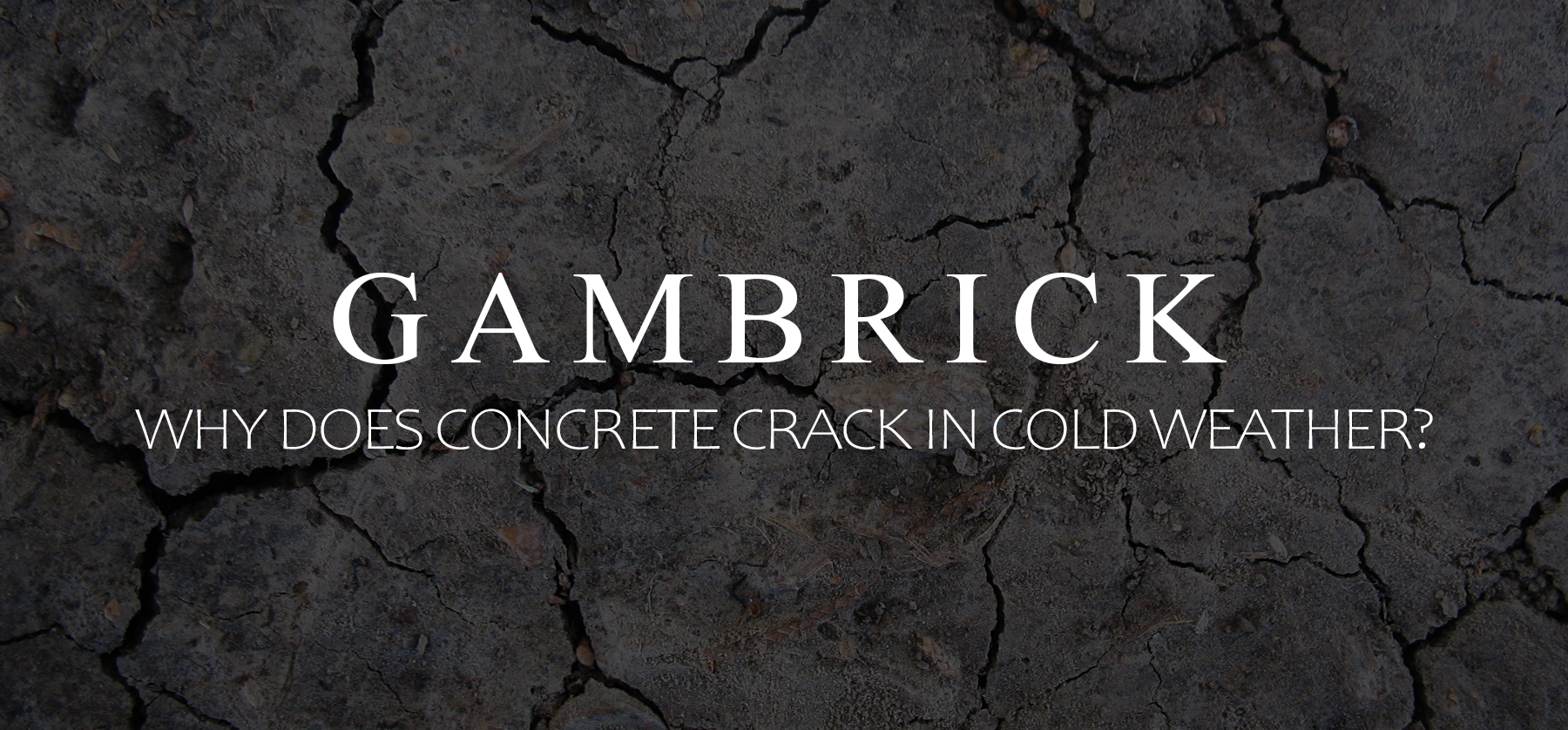
Why Does Concrete Crack In Cold Weather?
Concrete is a porous material that absorbs water like a sponge. When the temperature drops, moisture trapped inside the concrete freezes, causing it to expand which creates pressure. When the temperature warms, the frozen water melts and contracts. This is called the freeze/thaw cycle. Over time, this expansion and contraction pressure can make concrete crack. At first, these hairline cracks aren’t generally a problem. But over time, they’ll eventually get bigger and harder to fix. Larger amounts of water can get into the cracks, freeze and cause even more pressure. Eventually if left uncorrected, the cracks can break a concrete slab into chunks.
Unfortunately, cracks are one of the downsides to concrete. However it’s easy to repair and preventing cracks is possible by using rebar.
Rebar reinforces concrete from the inside. When it cracks, the rebar holds the slab together and keeps it strong. The best way to deal with concrete cracks is steel rebar and other forms of reinforcement.
The National Climatic Data Center reports that the average Winter temperature in 25 U.S states is below freezing. That can harm concrete and cause cracks.
Changes in temperature leads to repeated freezing and thawing, causing the concrete to crack and flake. When rain, ice, or snow migrates through cracks in the concrete, it saturates the substrate, causing the concrete to shift and move everything there is freezing and thawing.
The repeated movement expands the cracks or creates new ones. Although concrete acts as a rigid sponge, it will become saturated from rain, ice, and snow during the winter if you leave it unprotected.
Water that saturates the concrete expands due to freezing temperatures, causing the concrete surface to flake or spall. In today’s article, we’ll discuss what causes concrete cracking in cold weather and how you can prevent it.
Causes of Concrete Cracking in Cold Weather
Research shows that hydration is an essential chemical reaction that transforms semi-liquid concrete into a solid material. The mixture of water and cement powder causes a chemical reaction that leads to crystallization. The concrete’s temperature determines the speed of this chemical reaction.
For instance, the reaction proceeds faster during hot weather but slows down when it is cold. Once you have poured the concrete, the crystals will begin to grow, and it may take a few months before the concrete becomes solid or stronger. This process is called curing.
Concrete generally stops curing when the temperature drops below 14 degrees. The problems occur in the early life of new concrete. However, once the temperature increases, the crystals begin to grow again.
Because of this chemical reaction and the ingredients used to make concrete, it’s very porous. This means it absorbs and holds water like a sponge. Imagine a soaked sponge left outside to freeze. As the water froze the sponge would expand and crack. The same basic process occurs with concrete.
Slow Curing During Cold Weather
Concrete requires at least 30 days to cure, while the water vapors evaporate from within it. However, if there is snow or freezing weather, the curing process will slow down and won’t occur at the proper rate, causing the concrete to crack and crumble.
That’s why experts recommend not to pour concrete less than a month before you anticipate the first freeze. It is crucial to pour concrete on a day with a temperature above 40 degrees.
Cover the concrete with plastic and straw or hay to retain the heat if the overnight temperature drops below 40 degrees. That way, you can optimize the curing process. Although you can calcium chloride when doing cold weather pours, the Building Code of many communities does not permit this because it shortens the concrete life.
Thermal Cracking during Cold Weather
Thermal cracking is another cause of cracked concrete. It occurs due to excessive differences in temperature within a concrete structure and its surroundings. As a result, the temperature difference causes the cooler portions of the concrete to contract more, leading to restrained contraction.
Thermal cracking occurs when the restraint causes tensile stresses that exceed the tensile strength of the in-place concrete. When cementitious materials undergo hydration, they generate heat for a few days.
The heat dissipates in the thin sections rapidly and causes no problems. However, the internal temperature increases and decreases in the thicker areas, and the concrete surface cools quickly to ambient temperature.
Cold weather causes restrained surface contraction, creating tensile stresses that crack the concrete surface. The problem occurs due to uncontrolled temperature differences in the cross-section. Thermal cracking often occurs at early ages, especially when the surfaces are exposed to extreme temperatures.
Freezing and Thawing of Water
Although concrete is a durable material that can resist many things, cold weather during the winter season can damage it. Because concrete is a porous material, the water can undergo freezing and thawing, leading to increased stress on the surface that the material can’t handle. Consequently, you will see the formation of cracks on the concrete surface.
Research shows that when water freezes on the surface, the concrete expands by 9%, causing around 100,000 pounds of pressure per square inch on the concrete driveway or patio. Cold weather can cause repeated freezing and thawing of water, leading to increase moisture levels that can cause cracks.
Besides, salts that cement finishers lay down on the concrete surface to avoid slippery hazards can also damage concrete. Salts have higher tendencies to attract moisture or water, leading to increased moisture levels in concrete pores.
How to Prevent Concrete from Cracking in Cold Weather?
Sealing is one of the best ways to protect concrete surfaces from cracking during cold weather. However, you must do this before winter starts, so you can prevent extra moisture or water from seeping into the concrete pores. Apply a high-quality acrylic sealer is an excellent way to protect concrete from cracking in the cold winter months.
Repair concrete cracks require you to use a polyurethane sealant, allowing the concrete to move and shift without causing damages to the repair. Use a hammer and chisel to widen the cracks to about ¼ inches. Use a brush to clean the debris from cracks and then fill the cracks with a quality sealant using a standard caulk gun.
On the other hand, protecting concrete surfaces requires you to use a water-based acrylic sealer to make the surface waterproof and prevent spalling. Start by using a pressure washer to clean the surface and remove all the dirt, salts, grease, and other bond inhibitors.
When you apply the sealer on the surface, make sure you use a roller, brush, or garden sprayer. It is crucial to apply the sealer evenly on the concrete surface. You must apply a second coat two hours after the first application.
Moreover, you can use re-surfacer to transform old and worn sidewalks, patios, or driveways into new and durable concrete surfaces. Remember, this requires careful planning and preparation. You can start by cleaning the concrete surface to remove salts, greases, and dirt with a pressure washer.
Make sure you use a 3,500 PSI pressure washer to get the job done accurately. Apply the re-surfacer to the concrete surface and ensure it is not thicker than ¼ inches using a long-handled squeegee.
Summary: Why Does Concrete Crack In Cold Weather?
Concrete is a porous material that absorbs water like a sponge. When the temperature drops, moisture trapped inside the concrete freezes, causing it to expand which creates pressure. When the temperature warms, the frozen water melts and contracts. This is called the freeze/thaw cycle. Over time, this expansion and contraction pressure can cause cracks. At first, these hairline cracks aren’t generally a problem. But over time, they’ll eventually get bigger and harder to fix. Larger amounts of water can get into the cracks, freeze and cause even more pressure. Eventually if left uncorrected, the cracks can break a concrete slab into chunks.
Unfortunately, cracks are one of the downsides to concrete. Since it’s such a hard material, any movement at all can potentially cause a crack. However concrete is easy to repair and preventing cracks is possible.
The National Climatic Data Center reports that the average temperature in winter in 25 U.S states is below freezing that can harm concrete surfaces, especially when homeowners leave them unprotected.
Changes in the daytime and nighttime temperatures lead to repeated freezing and thawing, causing the concrete to crack and flake. When rain, ice, or snow migrates through cracks in the concrete, it saturates the substrate, causing the concrete to shift and move everything there is freezing and thawing.
The repeated movement expands the cracks or creates new ones. Although concrete acts as a rigid sponge, it will become saturated from rain, ice, and snow during the winter if you leave it unprotected.
Water that saturates the concrete expands due to freezing temperatures, causing the concrete surface to flake or spall. Why does concrete crack in cold weather? Freezing water.
If you have any questions or comments about concrete E-mail any time.

John Mazzuca | About | More Posts |
Custom Home Builder
John Mazzuca is a custom home designer and builder at Gambrick with over 25 years experience in the construction industry. John has designed, built and/or remodeled hundreds of homes, small buildings, and commercial projects. He writes about business, real estate, home building, and household electronics. His work has been featured in Fox Business, Better Homes & Garden, House Beautiful, and more.




















